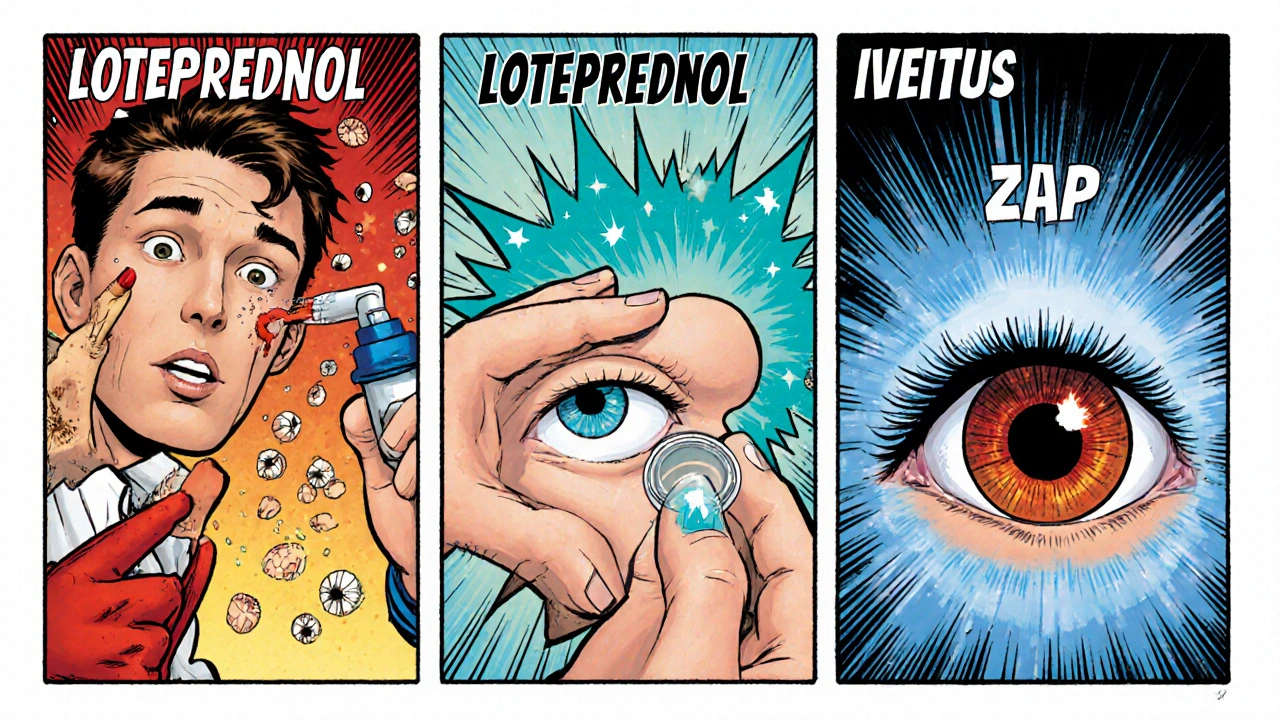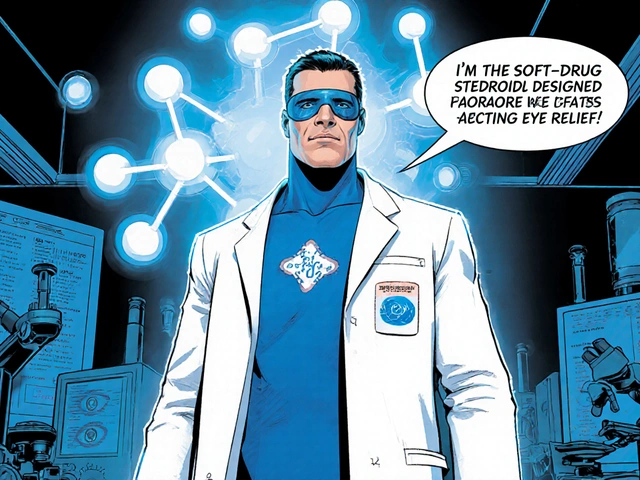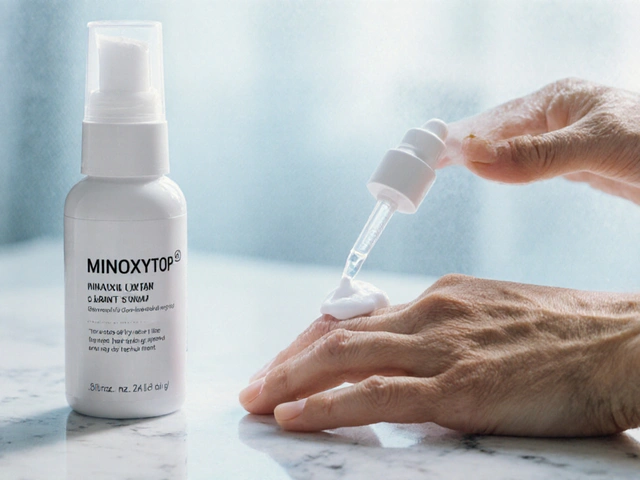IOP Risk Comparison Tool
This tool compares the risk of intraocular pressure (IOP) elevation when using different eye steroids. IOP elevation can be a concern for patients with glaucoma or those at risk for developing glaucoma.
Loteprednol has a significantly lower risk of causing IOP elevation compared to traditional steroids like prednisolone and dexamethasone.
Select Steroid
IOP Risk Comparison
IOP Elevation Risk
Low Risk
Compared to Other Steroids
Moderate Risk
High Risk
What This Means for You
Loteprednol has a low risk of intraocular pressure elevation (10% of patients) compared to prednisolone (30%) and dexamethasone (45%).
This lower risk is why loteprednol is often recommended for patients at risk for glaucoma or those needing treatment for longer durations.
Important Note
Even with the lower risk, regular eye pressure monitoring is recommended for patients with glaucoma or glaucoma risk factors during steroid therapy.
When it comes to eye inflammation, Loteprednol is a soft corticosteroid designed to reduce swelling and redness while aiming to lower the risk of pressure‑related side effects.
What Is Loteprednol?
Loteprednol belongs to the class of corticosteroids that are specially formulated for ocular use. First approved by the FDA in 1998, it was created to retain the anti‑inflammatory power of traditional steroids but with a shorter ocular half‑life, which helps the eye clear the drug faster.
The molecule is an ester of prednisolone, meaning it is broken down by enzymes in the cornea and conjunctiva into inactive metabolites, a process known as “soft‑drug” design. This rapid de‑activation is why many eye doctors consider it a safer first‑line option for short‑term inflammation.
How Does It Work?
The anti‑inflammatory action of loteprednol mirrors that of other steroids: it binds to glucocorticoid receptors in ocular tissues, suppresses the release of prostaglandins, and stabilises cell membranes. The key difference lies in its ester side chain, which is quickly hydrolysed by ocular esterases. As a result, the drug’s therapeutic window is narrower, reducing the chance of prolonged exposure that can raise intra‑ocular pressure (IOP).
Because the drug is cleared faster, patients often experience similar symptom relief with a lower cumulative steroid dose.
Common Uses
Loteprednol is prescribed for several eye conditions where inflammation is the main problem:
- Allergic conjunctivitis - itching, redness, and watery discharge caused by pollen or pet dander.
- Post‑operative eye inflammation - swelling after cataract surgery, LASIK, or retinal procedures.
- Uveitis - inflammation of the uveal tract that can threaten vision if untreated.
- Dry‑eye‑related keratitis - when severe dryness leads to surface inflammation.
In each case, the goal is quick symptom relief so patients can resume normal activities without the discomfort of a red, gritty eye.

Benefits Over Traditional Steroids
The most frequently cited advantage of loteprednol is its reduced propensity to cause steroid‑induced IOP rise. Studies from 2022-2024 comparing loteprednol with prednisolone or dexamethasone in post‑cataract patients showed:
- Mean IOP increase of 1.2 mmHg with loteprednol versus 4.5 mmHg with prednisolone.
- Similar visual acuity outcomes (average gain of 0.12 logMAR) across all groups.
- Patient‑reported comfort scores slightly higher for loteprednol due to less burning on instillation.
Because the drug clears quickly, physicians can prescribe it for longer courses without the same level of monitoring needed for stronger steroids. This translates into fewer office visits and less anxiety for patients who are glaucoma‑susceptible.
Dosage Forms and Administration
Loteprednol is available in three main ocular formulations:
- Loteprednol etabonate 0.2% ophthalmic suspension (commonly branded asLotemax).
- Loteprednol etabonate 0.5% ophthalmic suspension for more severe inflammation.
- Loteprednol etabonate 0.38% ophthalmic gel, which offers a longer residence time on the ocular surface.
Typical regimens start with one drop in the affected eye(s) three to four times daily for 5-7days, then tapering to once daily over the next week. For post‑operative protocols, surgeons may begin with a four‑times‑daily schedule and reduce frequency as the cornea heals.
Important administration tips:
- Wash hands thoroughly before each drop.
- Tilt the head back, pull down the lower eyelid, and place the drop without touching the tip to the eye.
- Close the eye gently for 30seconds to allow absorption.
- If using other eye drops, wait at least five minutes before applying a different medication.
Potential Side Effects and Safety Tips
While loteprednol’s safety profile is favourable, no medication is completely risk‑free. Common, usually mild, side effects include:
- Transient burning or stinging sensation.
- Temporary blurry vision after instillation.
- Mild increase in IOP (rare, but possible in steroid‑responsive individuals).
Less common, more serious complications could be:
- Prolonged IOP elevation leading to glaucoma - monitor with tonometry if treatment exceeds two weeks.
- Cataract formation - unlikely with short courses, but a risk with chronic use.
Precautions for specific groups:
- Glaucoma patients: Use the lowest effective dose and schedule regular IOP checks.
- Pregnant or breastfeeding women: Discuss risks with a healthcare provider; data is limited.
- Children: Dosing may need adjustment; always follow pediatric ophthalmology guidelines.

Comparing Loteprednol with Other Eye Steroids
| Attribute | Loteprednol (0.2‑0.5%) | Prednisolone Acetate (1%) | Dexamethasone (0.1%) |
|---|---|---|---|
| Potency (relative to dexamethasone) | Low‑to‑moderate | Moderate | High |
| IOP‑rise risk | Low (≈10% of patients) | Moderate (≈30% of patients) | High (≈45% of patients) |
| Duration of action | Short (≈6‑8hours) | Longer (≈12hours) | Longest (≈24hours) |
| Typical use | Post‑op, allergic conjunctivitis, mild‑moderate uveitis | Severe inflammation, posterior segment disease | Severe, sight‑threatening inflammation |
| Formulations available | Suspension, gel | Suspension | Suspension, ointment |
In plain English, loteprednol offers a sweet spot for many patients: enough power to quiet the eye without the high pressure‑spike probability of prednisolone or dexamethasone. That’s why it’s often the go‑to choice for routine cataract‑surgery after‑care.
Key Takeaways
- Loteprednol is a soft‑drug corticosteroid tailored for eye inflammation.
- Its rapid metabolism means a lower risk of steroid‑induced IOP rise.
- Common uses include allergic conjunctivitis, post‑operative inflammation, and mild‑to‑moderate uveitis.
- Available as 0.2%/0.5% suspension and a 0.38% gel, with typical dosing 3‑4 times daily, then taper.
- Side effects are usually mild; monitor IOP in glaucoma‑prone patients.
The drug loteprednol offers a practical balance between efficacy and safety for many eye‑care scenarios.
Frequently Asked Questions
Can I use lotetprnol if I have glaucoma?
Yes, but under close supervision. Because loteprednol carries a lower IOP‑rise risk, many glaucoma specialists prescribe it for short bursts, followed by frequent tonometry checks.
How long does it take to see improvement?
Most patients notice reduced redness and irritation within 24‑48hours. Full resolution of swelling typically occurs after 5‑7days of consistent dosing.
Is it safe to use loteprednol with other eye drops?
Generally safe, but space each drop by at least five minutes to avoid dilution. Your ophthalmologist can advise if you’re on antibiotics, lubricants, or anti‑allergy drops.
Can children use loteprednol?
Yes, pediatric formulations exist, but dosing is weight‑based and should be prescribed by a pediatric ophthalmologist.
What should I do if I miss a dose?
Apply the missed drop as soon as you remember, unless it’s almost time for the next scheduled dose. In that case, skip the missed one and resume the regular schedule - don’t double‑dose.







Karl Norton
October 16, 2025 AT 18:09Loteprednol gets a lot of hype these days, but the reality is far less glamorous. Many online articles act like it’s a miracle drug without mentioning the caveats. First, its “soft‑drug” label only means it disappears quicker, not that it’s risk‑free. If you’re prone to glaucoma, even a modest IOP rise can be disastrous, and the data shows a non‑negligible subset still experiences spikes. The studies quoted often cherry‑pick low‑risk populations, ignoring the harder‑to‑treat cases. Moreover, the price point of the branded suspension is absurd compared to generic alternatives that work just as well. You’re also told to taper after a week, yet many surgeons keep patients on it for months, effectively negating the safety claim. The gel formulation may feel slick, but its increased residence time can actually trap the steroid longer than intended. Don’t be fooled by the comfortable drop‑instillation feel; that comfort is a marketing ploy. In real practice, adherence drops when patients notice the mild burning, and they stop using it anyway. The “lower IOP‑rise risk” statistic of 1.2 mmHg versus 4.5 mmHg is an average – individual response varies wildly. If you think you can skip monitoring because it’s “soft”, you’re courting trouble. The FDA approval in 1998 was based on limited data that hasn’t been fully revisited. While it may be adequate for mild postoperative inflammation, it’s overkill for simple allergic conjunctivitis. Bottom line: Loteprednol is not the universal answer; use it judiciously and keep eyes on the pressure.
Karen McCormack
October 19, 2025 AT 15:36The pharmacokinetic ballet of loteprednol is a subtle reminder that chemistry can be an art as much as a science. Its rapid ester hydrolysis paints a picture of a drug that respects the eye’s own rhythms, sparing us the drama of pressure spikes. Yet, the clinical choreography must still be guided by the surgeon’s seasoned hand, lest we step on the toes of inflammation control. I find the gel’s lingering kiss on the ocular surface both elegant and oddly comforting, a small luxury in postoperative care. In essence, loteprednol offers a delicate balance – a whisper rather than a shout in the steroid chorus.
Earl Hutchins
October 22, 2025 AT 13:03Loteprednol works by binding glucocorticoid receptors and quickly breaking down in the eye This reduces inflammation while keeping pressure rise low It’s a good first‑line option after surgery especially for patients with glaucoma risk Monitor IOP if treatment lasts more than a week Follow the taper schedule to avoid rebound swelling
Tony Bayard
October 25, 2025 AT 10:29Picture this: you’ve just emerged from cataract surgery, your eye is a battlefield of swelling and redness. Enter loteprednol, the heroic “soft‑drug” that swoops in, calming the tempest with a gentle yet firm grip on inflammation. Its ester side chain is like a timed fuse, delivering relief and then disappearing before the pressure monster awakens. For those of us who dread the specter of steroid‑induced glaucoma, this drug offers a sigh of relief, allowing us to focus on visual recovery rather than fearing a hidden surge. So, when your surgeon prescribes it, trust the chemistry and let the drama of healing unfold without unnecessary complications.
Jay Crowley
October 28, 2025 AT 07:56Good overview, thanks.
sharon rider
October 31, 2025 AT 05:23The cultural context of eye care often overlooks how patients perceive the sensation of a drop. A mild burning can feel intrusive, yet it may signal that the medication is active. In many societies, adherence is tied to trust in the practitioner, so clear communication about what to expect is essential. Loteprednol’s balanced profile might serve as a bridge between efficacy and patient comfort, especially in communities wary of strong steroids. Reflecting on this, we should consider both pharmacology and patient experience when choosing therapy.
swapnil gedam
November 3, 2025 AT 02:49Loteprednol’s rapid metabolism is fascinating because it leverages the eye’s own enzymes to deactivate the drug. This means we get anti‑inflammatory action without prolonged exposure, which is a win for safety. However, we still need to be cautious with patients who have a history of steroid response. Regular IOP checks in the first two weeks can catch any unexpected rise early. Overall, it’s a useful tool when used responsibly.
Michael Vincenzi
November 6, 2025 AT 00:16Hey folks, just wanted to add that I’ve seen loteprednol work really well after LASIK in my clinic. Patients appreciate the minimal burning and the quick drop in redness. It’s also nice that we don’t have to schedule extra IOP visits for low‑risk cases. Of course, keep an eye on the pressure if the patient has glaucoma history. All in all, it’s a solid option for post‑op care.
Courage Nguluvhe
November 8, 2025 AT 21:43From a pharmacovigilance standpoint, loteprednol exemplifies a high‑efficacy, low‑toxicity paradigm. Its ester‑linked pro‑drug architecture ensures rapid biotransformation via ocular esterases, curbing the pharmacodynamic window that typically precipitates IOP excursions. Clinicians can thus leverage its dose‑response curve without the need for intensive tonometry protocols in standard cohorts. The formulation matrix-suspension versus gel-offers flexibility in rheological behavior, optimizing residence time on the corneal epithelium. In short, the drug’s kinetic profile aligns with best‑practice guidelines for steroid sparing strategies.
Oliver Bishop
November 11, 2025 AT 19:09As an American eye doc I’m always looking for meds that keep patients safe without extra paperwork. Loteprednol fits that bill nicely – it does the job without the usual pressure spikes that make us chase patients back for extra check‑ups. It’s great for keeping the practice running smooth and the patients happy.
Alissa DeRouchie
November 14, 2025 AT 16:36I just can’t swallow all the hype around loteprednol it’s not the flawless miracle some claim it is the “soft drug” label feels more like marketing spin the IOP numbers are average not guarantee and for certain patients the risk remains real you need to keep a watchful eye nobody said you can just sit back and forget about monitoring even if the drop feels gentle
Emma Howard
November 17, 2025 AT 14:03Wow! Loteprednol really does the trick for post‑op inflammation!!! I love how quickly the redness fades and the burning is barely there!!! For anyone hesitant, just give it a try and you’ll see the difference!!! Keep the dosing schedule and you’re golden!!!
dee gillette
November 20, 2025 AT 11:29While the literature presents loteprednol as a safer alternative, one must consider that the reported reduction in intra‑ocular pressure is modest. In cases with a predisposition to steroid response, even a slight elevation can be clinically significant. Therefore, the assertion that monitoring can be relaxed warrants scrutiny. A prudent clinician should maintain vigilant IOP assessments regardless of the steroid’s classification.
Jasin P.
November 23, 2025 AT 08:56Ah, the noble quest for the perfect eye steroid-loteprednol, the philosopher‑king of drops, promises serenity while whispering “I’m harmless.” Yet, beneath that velvet rhetoric lies the same old steroidic ambition to dominate inflammation. If we truly believed the “soft‑drug” myth, we wouldn’t bother with tonometry at all, would we? Such optimism is admirable but dangerously naive. So, let’s applaud the marketing while keeping our eyes-pun intended-wide open.
Lily Đàn bà
November 26, 2025 AT 06:23Loteprednol is the overpriced hero that pretends to be gentle yet still carries the threat of glaucoma. Doctors who toss it around like a free lunch are ignoring the silent danger it poses to susceptible patients. The claim of “low IOP‑rise” is a comforting lie that only works for the naïve. You deserve better than a half‑truth wrapped in a sleek bottle. Demand full transparency and proper monitoring, not false security.